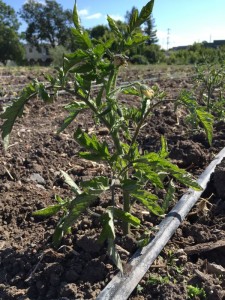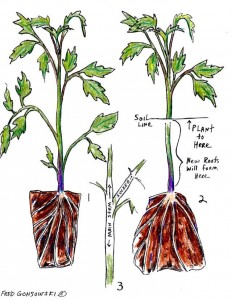It’s mid-May, which means we all best be getting our tomatoes in the ground if we haven’t yet! Over at Petaluma Bounty we just planted around 300 of them in the ground and are getting ready to set up our trellis. I try not to stare at them for fear my hovering will slow down their growth (watched pots and all that). So while I attempt to patiently wait for things to take off on my end, I thought this would be a great time to discuss best practices for growing tomatoes with all you gardeners at home. There a few common mistakes gardeners make when growing tomatoes, but this year you don’t have to.
Whether you started your plants from seed or bought transplants, it’s a great time to get tomatoes in the ground and start the long journey toward delicious fruit all summer long. Below we’ve listed out basic tomato planting and care guidelines, and the super common mistakes you’ll want to avoid.
Step 1: Choose which tomato variety you want to grow
This can be pretty subjective. Do you like to eat red tomatoes, yellow tomatoes, or cherry tomatoes? When in doubt, try one of each! But remember, one tomato plant goes a long way, so it’s good to plan ahead and can or freeze extra tomatoes that you can’t eat during the summer. You can probably expect 8 – 15 pounds of fruit off of each tomato plant. Ask around to your local farmers or master gardeners to see what grows well in your area.

Here is a list of tried and true varieties that do quite well for us at Petaluma Bounty:
Red
Stupice
Thessaloniki
Cherokee Purple
Brandywine
New Girl
San Marzano (for saucing)
Black
Black Krim
Black Prince
Japanese Black Trifele
Green
Green Zebra
Cherry
Sungold
Chadwick Cherry
Sebastopol Cherry
Step 2: Decide on seeds or transplants for growing tomatoes
If starting from seed, the process begins in the deep depths of winter. I usually start my tomato seeds in mid-February and don’t get them planted in the ground until early May. To start from seed, sow them in moist soil mix in cell trays, flats or pots, with about half an inch between seeds. Cover lightly with soil mix and water in gently, and then keep in a warm, sunny spot to germinate and then grow into healthy little seedlings. Continue to water about once a day to keep the soil moist. Once they have a few sets of leaves (usually about 6 weeks later), you can carefully ‘pot them up’ into individual containers – 2″ or 4″ pots work really well. At this point you should water them more deeply but less frequently – thoroughly drenching the pots about once a day if the weather is warm and the top few inches of soil dry down.
Step 3: Plant your tomatoes
Plant either in the ground or in a large pot – 5 gallons at least – or a deep planter. Since tomatoes have deep roots and are heavy feeders, it’s really not worth trying to cram them into smaller containers. You’ll want to choose the sunniest of the sunny spots and allow for about two feet between plants. If planting in the ground, it’s really worth your time to wait until the ground dries out and the temperatures rise. Here is a great article on how to know if your soil is dry enough to work. Mid to late April into early May is safe in Sonoma County. Sometimes with a hot dry winter such as this one you can get away with an earlier planting, but don’t be fooled by soaring daytime temperatures in March – wait it out!
We’ve talked before on the blog about the importance of proper soil care. It’s best to always think about the setting up the most hospitable environment for your plants’ fragile roots. For tomatoes, the tilth of your soil – that is, its physical condition and the size of all of its clumps – doesn’t need to be especially fine. But you don’t want to plant into huge, hard clods either. Loosen the soil with a digging fork and work in a few inch layer of compost before doing any planting. If possible, come in a few days before planting, add compost, and water thoroughly, letting the water percolate down through the soil over the subsequent days. Healthy soil, healthy plants.
A common gardening mistake when growing tomatoes is planting them too shallow or too close together. Tomatoes actually like to be planted quite deep – you can actually bury the first and even the second set of leaves. They will grow better and stronger if you do so, as roots will form from the length of the stem that’s underground.

At planting or soon after, I like to come in and give my tomatoes an extra dose of food in the way of a balanced organic fertilizer, extra compost scratched into the surface, compost tea sprayed onto the root area to drench them, or all of the above. Tomatoes are pretty heavy feeders, and will pay you back with fruit all summer long. After this initial feeding, I aim for one more right around the time when the fruit begins to grow on the plant.
Step 4: Water Your Growing Tomatoes
Give them a real good first drenching. Then come back to water whenever your soil dries down – but not before. In my heavy clay soil, this means once every three days or so. I’ve seen so many people over water their tomatoes, it’s one of the most common gardening mistakes out there when it comes to growing tomatoes. Don’t join their ranks! As the tomato plant is focused on vegetative growth – that is, growing a big strong plant – it enjoys regular, deep waterings with sufficient dry-down in between.
BUT, when the plants begin to set fruit, their needs change. In order to support the plant’s shift from vegetative growth to producing fruit, it needs to be a little stressed for water. So at this point reduce your watering to just twice a week or so, and continue with moderate and not deep waterings.
Step 5: Support Your Growing Tomatoes
Cages or twine works well. There are a million ways to train and prune tomato plants, but I encourage gardeners to just support them well, train low-hanging branches up the support system as they grow, and there should be no real need for pruning.
Voila, tomatoes for everyone! Next time on the blog we’ll be talking about soil nutrition – what you need to know, and what to do about deficiencies and imbalances in your soil. Until then, get out and plant some tomatoes! Do you have a favorite tomato variety or growing tip? Share with us in the comments section below. Or if you have any further questions about growing the best tomatoes possible leave a comment below and I’ll be happy to help.







 Family
Family

